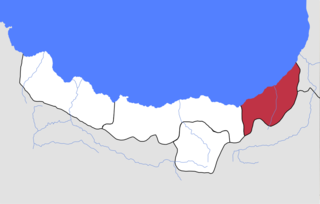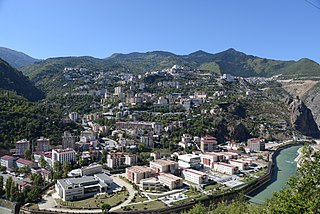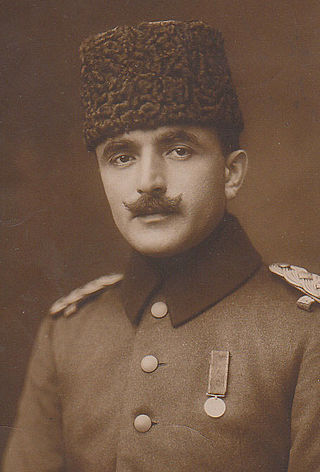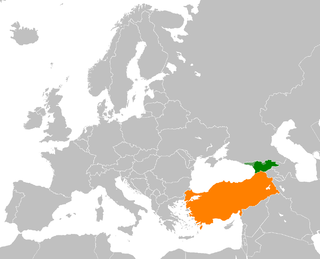
Trabzon, historically known as Trebizond, is a city on the Black Sea coast of northeastern Turkey and the capital of Trabzon Province. Trabzon, located on the historical Silk Road, became a melting pot of religions, languages and culture for centuries and a trade gateway to Persia in the southeast and the Caucasus to the northeast. The Venetian and Genoese merchants paid visits to Trabzon during the medieval period and sold silk, linen and woolen fabric. Both republics had merchant colonies within the city – Leonkastron and the former "Venetian castle" – that played a role to Trabzon similar to the one Galata played to Constantinople. Trabzon formed the basis of several states in its long history and was the capital city of the Empire of Trebizond between 1204 and 1461. During the early modern period, Trabzon, because of the importance of its port, again became a focal point of trade to Persia and the Caucasus.

The Treaty of Sèvres was a 1920 treaty signed between some of the Allies of World War I and the Ottoman Empire, but not ratified. The treaty would have required the cession of large parts of Ottoman territory to France, the United Kingdom, Greece and Italy, as well as creating large occupation zones within the Ottoman Empire. It was one of a series of treaties that the Central Powers signed with the Allied Powers after their defeat in World War I. Hostilities had already ended with the Armistice of Mudros.

The Turkish War of Independence was a series of military campaigns and a revolution waged by the Turkish National Movement, after the Ottoman Empire was occupied and partitioned following its defeat in World War I. The conflict was between the Turkish Nationalists against Allied and separatist forces over the application of Wilsonian principles, especially self-determination, in post-World War I Anatolia and eastern Thrace. The revolution concluded the collapse of the Ottoman Empire, ending the Ottoman sultanate and the Ottoman caliphate, and establishing the Republic of Turkey. This resulted in the transfer of sovereignty from the sultan-caliph to the nation, setting the stage for nationalist revolutionary reform in Republican Turkey.

Rize Province is a province of northeast Turkey, on the eastern Black Sea coast between Trabzon and Artvin. The province of Erzurum is to the south. Its area is 3,835 km2, and its population is 344,016 (2022). The capital is the city of Rize. It was formerly known as Lazistan, however the designation of the term of Lazistan was officially banned in 1926.

Artvin Province is a province in Turkey, on the Black Sea coast in the northeastern corner of the country, on the border with Georgia. Artvin also borders the Turkish provinces of Erzurum, Ardahan and Rize. Its area is 7,393 km2, and its population is 169,403 (2022). The provincial capital is the city of Artvin.

Lazistan was the Ottoman administrative name for the sanjak, under Trebizond Vilayet, comprising the Laz or Lazuri-speaking population on the southeastern shore of the Black Sea. It covered modern day land of contemporary Rize Province and the littoral of contemporary Artvin Province.

Artvin is a city in northeastern Turkey about 30 kilometres inland from the Black Sea. It is the seat of Artvin Province and Artvin District. Its population is 25,841 (2021).

The Vilayet of Trebizond was a first-level administrative division (vilayet) in the north-eastern part of the Ottoman Empire, corresponding to the area along the eastern Black Sea coastline and the interior highland region of the Pontic Alps.

The Turkish–Armenian War, known in Turkey as the Eastern Front of the Turkish War of Independence, was a conflict between the First Republic of Armenia and the Turkish National Movement following the collapse of the Treaty of Sèvres in 1920. After the provisional government of Ahmet Tevfik Pasha failed to win support for ratification of the treaty, remnants of the Ottoman Army's XV Corps under the command of Kâzım Karabekir attacked Armenian forces controlling the area surrounding Kars, eventually recapturing most of the territory in the South Caucasus that had been part of the Ottoman Empire prior to the Russo-Turkish War (1877–1878) and was subsequently ceded by Soviet Russia as part of the Treaty of Brest-Litovsk.

Wilsonian Armenia was the unimplemented boundary configuration of the First Republic of Armenia in the Treaty of Sèvres, as drawn by U.S. President Woodrow Wilson's Department of State. The Treaty of Sèvres was a peace treaty that had been drafted and signed between the Western Allied Powers and the defeated government of the Ottoman Empire in August 1920, but it was never ratified and was subsequently superseded by the Treaty of Lausanne. The proposed boundaries of Wilsonian Armenia incorporated portions of the Ottoman vilayets of Erzurum, Bitlis, Van, and Trabzon, which had Armenian populations of varying sizes. The inclusion of portions of Trabzon Vilayet was intended to provide the First Republic of Armenia with an outlet to the Black Sea at the port of Trabzon. A proposed Republic of Pontus was discussed at the Paris Peace Conference of 1919, but the Greek government of Eleftherios Venizelos feared the precarious position of such a state, so a portion of it was instead included in the proposed state of Wilsonian Armenia.

The Laz people, or Lazi, are a Kartvelian ethnic group native to the South Caucasus, who mainly live in Black Sea coastal regions of Turkey and Georgia. They traditionally speak the Laz language but have experienced a rapid language shift to Turkish.

The partition of the Ottoman Empire was a geopolitical event that occurred after World War I and the occupation of Constantinople by British, French, and Italian troops in November 1918. The partitioning was planned in several agreements made by the Allied Powers early in the course of World War I, notably the Sykes–Picot Agreement, after the Ottoman Empire had joined Germany to form the Ottoman–German alliance. The huge conglomeration of territories and peoples that formerly comprised the Ottoman Empire was divided into several new states. The Ottoman Empire had been the leading Islamic state in geopolitical, cultural, and ideological terms. The partitioning of the Ottoman Empire after the war led to the domination of the Middle East by Western powers such as Britain and France, and saw the creation of the modern Arab world and the Republic of Turkey. Resistance to the influence of these powers came from the Turkish National Movement but did not become widespread in the other post-Ottoman states until the period of rapid decolonization after World War II.

The Black Sea region is a geographical region of Turkey. The largest city in the region is Samsun. Other big cities are Zonguldak, Trabzon, Ordu, Tokat, Giresun, Rize, Amasya and Sinop.

According to the memories of Nikita Khrushchev, the deputy premier Lavrentiy Beria (1946–1953) pressed Joseph Stalin to claim eastern Anatolian territory that had supposedly been stolen from Georgia by the Turks. For practical reasons, the Soviet claims, if successful, would have strengthened the state's position around the Black Sea and would weaken British influence in the Middle East.

The Batum oblast was a province (oblast) of the Caucasus Viceroyalty of the Russian Empire, with the Black Sea port of Batum as its administrative center. The Batum oblast roughly corresponded to the present-day Adjara autonomous region of Georgia, and most of the Artvin Province of Turkey.

Place name changes in Turkey have been undertaken, periodically, in bulk from 1913 to the present by successive Turkish governments. Thousands of names within the Turkish Republic or its predecessor the Ottoman Empire have been changed from their popular or historic alternatives in favour of recognizably Turkish names, as part of Turkification policies. The governments have argued that such names are foreign or divisive, while critics of the changes have described them as chauvinistic. Names changed were usually of Armenian, Greek, Georgian, Laz, Bulgarian, Kurdish (Zazaki), Persian, Syriac, or Arabic origin.

The Caucasus Greeks, also known as the Greeks of Transcaucasia and Russian Asia Minor, are the ethnic Greeks of the North Caucasus and Transcaucasia in what is now southwestern Russia, Georgia, and northeastern Turkey. These specifically include the Pontic Greeks, though they today span a much wider region including the Russian north Caucasus, and the former Russian Caucasus provinces of the Batum Oblast' and the Kars Oblast', now in north-eastern Turkey and Adjara in Georgia.

Lazistan or Lazeti is a historical and cultural region of the Caucasus and Anatolia, the term was primarily used during Ottoman rule in the region. Traditionally inhabited by the Laz people and located mostly in Turkey, with small parts in Georgia, its area is about 7,000 km2 with a modern-day population of around 500,000.

The Georgia–Turkey border is 273 km in length and runs from the Black Sea coast in the west to the tripoint with Armenia in the east.

The Laz Rebellion was a series of uprisings against the representatives of the Ottoman Empire in the Trabzon Eyalet between 1832 and 1834. The rebellion was led by Tahir Ağa Tuzcuoğlu, who aimed to resist the arbitrary decisions of the local Ottoman governors and to restore the rights of local feudal lords. Initially, the rebels experienced success, particularly in January 1833, but the rebellion was ultimately suppressed in the spring of 1834.



















